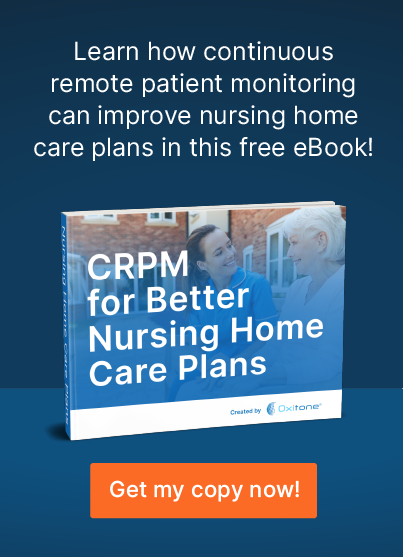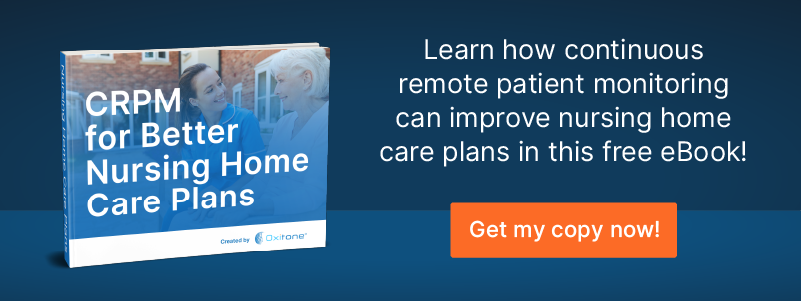Understanding the differences between traditional remote monitoring and continuous monitoring
Continuous monitoring is one of these buzz phrases that gets tossed around in healthcare, especially when it comes to the management of complex and geriatric patients. But what is continuous monitoring exactly, and how is it any different than the traditional remote monitoring in place now? This article will discuss this and more, bringing in specific patient cases to illustrate how advanced continuous monitoring systems can fill in the gaps to streamline care.
First, it is important to acknowledge that the current management of complex patients is a strain on the healthcare system. This is reflected in the providers and the patients. On the provider level, managing complex patients, such as those who have multiple comorbidities or who are not actively engaged in their disease care, can lead to a working environment with unnecessarily high stress. In a recent study, primary care providers were asked about their experiences treating complex patients. Providers reported spending an excessive amount of time coordinating care with these patients, whether it was contacting other providers to relay information or using frequent follow-up visits to manually manage medication regimens to evaluate the patient’s status. Providers described the amount of stress that this process creates, with the researchers finding that their responses warranted risk for burnout. For many primary care providers, it is clear that the current systems aren’t working. Care is disjointed across many clinical areas, not all providers have all the information, and half of the battle is obtaining the right information you need to be able to evaluate the patient.
Along with this, discontinuous medical management of complex patients increases the likelihood of hospital readmissions, which is harmful for the patient and the system. Being admitted to the hospital multiple times is linked with a greater risk of infection, health consequences (such as bed ulcers or mobility problems), and delirium or mental inattention associated with hospital stays. It also represents a sudden break from their normal routine, which can interfere with their home health management habits and their relationships with friends, family members, and work colleagues. Readmissions due to chronic health conditions are also costly to both providers and payers. A federal analysis of Medicare claims found that thirty-day readmissions cost healthcare systems $4.3 billion in hospital costs. Many of these medical readmissions were preventable—if the signs of decline had been seen earlier and corrected in real time. Furthermore, chronic health conditions like congestive heart failure (CHF) are particularly expensive. According to a recent health economics meta-analysis, CHF is the sixth costliest condition in US hospitals, and a quarter of that cost is made up of preventable hospital readmissions. In fact, CHF costs are expected to rise to almost $70 billion by 2030 (from $31 billion in 2012). Innovative methods of care coordination are needed to place these patients at the center and ensure better outcomes alongside high-value care.
So, what’s the solution to this problem? Traditionally, remote monitoring was thought to be a way to minimize follow-up appointments and reduce hospitalizations. However, traditional remote monitoring is limited and does not provide the wealth of data needed to manage these patients, who often have difficulty completing remote monitoring requirements—from using tools like blood pressure (BP) cuffs incorrectly at home to inadequate tech literacy, resulting in missed data. In a cohort study of adult patients with type 2 diabetes mellitus, remote monitoring led to a series of drawbacks: there were issues with patients using the technology itself, and the findings did not always integrate with the electronic medical record (EMR) system, thus rendering the data useless. During this experience with traditional remote monitoring, providers stated that the issues with EMR integration specifically led to subsequent interruption to workflow and delayed care.
Continuous patient monitoring via medical devices that leverage wearable technology has emerged as an exciting solution that is both patient-friendly and seamlessly integrated with the healthcare system. The Agency for Healthcare Research and Quality agrees; it recently released a white paper on caring for complex patients, highlighting the use of continuous monitoring and EMR-integrated tools for improving patient outcomes. The Centers for Disease Control and Prevention has also endorsed the use of continuous monitoring for patients living with chronic diseases.
The difference between remote patient monitoring and continuous patient monitoring is access to potentially life-saving information. In traditional remote patient monitoring, the patient is provided with tools like a BP cuff, a pulse oximeter, etc. and can send their measurements at regular intervals or during telemedicine appointments with their physician. However, as most providers know, many patients with complex health conditions like COPD and CHF have vital signs that vary widely throughout the day, and the pattern of vitals is more important than any single reading. Furthermore, some patients with severe chronic conditions, like stage 3 and 4 CHF and COPD, cannot be actively engaged in their disease care. For these patients and others, passive monitoring is needed that doesn’t require any activity or effort from the patient to make potentially life-saving measurements. For example, the three most critical values for assessment of chronic illnesses (as well as for COVID-19) are Sp02, pulse rate, and respiratory rate. One-click, real-time clinical continuous data access to these metrics rapidly accelerates the provider’s diagnostic assessment of the patient, which allows for early intervention.
Continuous patient monitoring leaps forward by continuously collecting patient vital signs, collating these measurements into a central and accessible depository, and applying sophisticated AI strategies to predict adverse events or the potential need for hospitalizations based on the patient’s known health history. Cardiopulmonary diseases, sleep apnea, and physiological stress are just three of the many health conditions that can be monitored carefully using measurements gleaned from the Oxitone system. Oxitone has a state-of-the-art continuous monitoring system that takes in all of the above and more to provide clinicians with the data needed to support the patient’s health and well-being for years to come.
Here at Oxitone, we boost value-based healthcare by delivering extraordinary patient, clinical, and economical outcomes at reduced medical utilization and cost. Patients need a prompt response to emergencies. Physicians need an easy and timely follow-up with patients. Our mission is to transform chronic disease management and help save lives worldwide.
Let’s save lives together! To see how we help remote patient monitoring companies and physicians improve the management and care of high-risk patients, contact us today!


